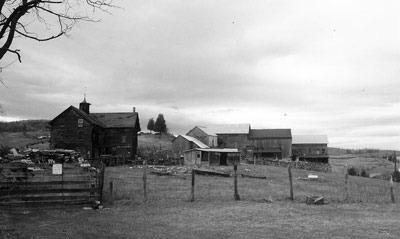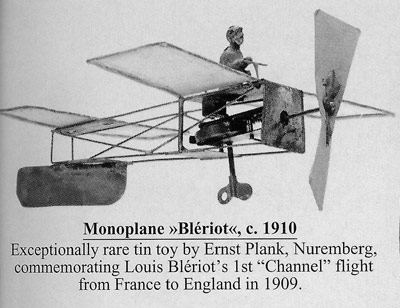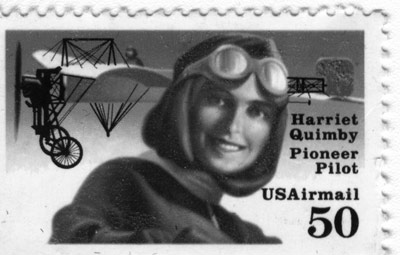
Sam, Paul, and Howard Quimby
A Conversation with the Quimby Brothers of Marlboro
Winter 2010
On March 11, 1888, no one knew the falling flakes were anything more than a late-season snow. But by March 14th, everyone knew it was destined for the record books. It was the “Blizzard of ’88.”
Phoebe Baxter Quimby of Marlboro was concluding a visit to nearby Plattekill. To make it home, Phoebe’s brothers ended up shoveling a path for her horse and sleigh. They made their way home before the full force of the snow closed down the Northeast. That blizzard killed more than 400 people and cost over 25 million dollars (1.2 billion in current dollars). The losses were mainly from fires no one could reach. Snow totals hit 58″ in the Northeast with wind gusts up to 80mph. Drifts were huge. Phoebe and her brothers were very lucky.
Today, Phoebe Quimby’s grandsons, brothers—Sam, Howard, and Paul, are all handsome and strong looking, ranging in age from 75 to 86. They all still live in Marlboro where they continue their productive, happy lives.
Sam Quimby has brown eyes and is clean shaven, Howard’s eyes are blue and he sports a full white beard. The clean-shaven youngest brother, Paul, has green eyes. Regardless of the color, the brothers all have “smiling eyes.” They speak beautifully, and laugh readily. It is a warm and compatible little group we make sitting around the wooden table in Sam and Jane Quimby’s lovely yellow house talking about their grandmother and the Blizzard of ’88 and anything else that pops up in one their quick minds.
The Quimby home sits cheek to jowl by Route 9W north of the Marlboro village. The farm land and barns behind the house are pristine. Sam tells me that where we sit was the tenants’ house for the Louis DuBois farm. Behind it is the main house, (now the George and Marie Rusk home) dating from the mid 1700s. In addition to being lovely, the Rusk house boasts a cannon ball lodged in an interior beam shot by Vaughn’s Expedition up the Hudson during the American Revolution. Also unusual, the farm still has its ice house.
The Quimby’s great-grandfather, Cornelius, was born in 1808 and died fairly young. His wife survived until 1900. Their son, the grandfather of the men I’m talking, to was, John C. Quimby, born in 1845.
The father of the current trio, Samuel J. Quimby, was born in 1887. He and his wife, Emma Schulman, bought their first farm of 30 acres in Marlboro in 1911. This farm is now the Glorie Winery where the original Quimby house still stands.

Quimby farm in Marlboro
The family purchased a second farm of eighty acres in 1930. Howard lives with his wife, Phoebe, on this farm. He grows wine grapes for winemakers and roadside stands. Howard is probably better known as the bon-vivant farmer. (Locals secretely wonder if Ralph Lauren and other designers of casual attire don’t sneak into Marlboro and photograph Howard for ideas in “the essence of the cool farm look.”).
Eldest brother, Samuel John Quimby, Jr. was born December 31, 1924 on the family farm, Lattintown Road, Marlboro.
Sam’s father (Samuel J. Quimby, Sr.) was a farmer and butcher. He was well known for his useful advice for the treatment of ailing animals. Neighbors used him as pre-vet/free-vet, and depended on his advice. He loved to buy animals and had a car with a “pen” built in the trunk so he could bring home his latest purchase. Eventually, he bought a pickup truck so he could purchase flocks of sheep, horses, or other barnyard critters and “filled all the barns up.”
Both Quimby parents were hard working, which pretty much sums up the farming life. Paul adds and the other two agree, “They were very good parents.”
Sam, Jr. attended first grade through high at the “button factory” school and graduated with 27 other students in 1943. He played basketball (1941 undefeated team, he reports), ran track, and was supported by his brother, Howard, who took up the slack in farm chores while Sam attended practice for sports. Howard said he didn’t mind, but Sam praises him anyhow, still voicing his appreciation for the opportunities Howard’s generosity afforded him. Sam says although none of the brothers went to college, “if one had, it should have been Howard–he was the smartest.”
After high school, Sam worked on the family farm. He recalled a summer hotel on Lattintown Road owned by a “punch-drunk” ex-boxer. There, Sam also met boxer Floyd Patterson. Floyd, originally from Brooklyn, had gone to the Wiltwyck School for troubled boys in Esopus, and later, made a name for himself winning in the 1954 Olympics.
Much of life for the Quimby brothers on the farm in the 1930s was duplicated on other small farms in the Hudson Valley. It included raising and bartering chickens and eggs, growing, bartering and selling vegetables, tending cows, raising and slaughtering pigs, and driving produce trucks.
The large practicing Jewish population in Sullivan County wanted the Kosher flour ground under the direction of a rabbi at the Tuthill Gristmill in Gardiner. Sam would haul the flour for them to Ellenville by truck. Today the gristmill is a fine new restaurant.
Paul Barton Quimby was born July 7, 1936. He went kindergarten through high school in what is now the Marlboro middle school. He served in the National Guard for nine years.
Initially Paul helped Sam in the produce business. At 18, he was driving a 10-ton vehicle to the Washington Terminal in Brooklyn, also to Boston. “Before the Thruway, the NYC trips took four to five hours,” he said.
Paul also helped on the farm, but it was not ‘his calling” and after a number of part-time jobs, he worked for the Mid-Hudson Produce auction. Eventually, he bought and ran the auction house. Local farmers sold their produce through his services. Strawberries, cherries, apples, peaches, plums, and tomatoes were all very important crops. Paul learned the auctioneering business on his own. “I enjoyed the challenge–each day was a new beginning. And business was good until the early 1980s, then the smaller farms went out. So did the auction business.”
Tomatoes were an important crop in the area: packaging, picking, hauling, buying, selling. Green tomatoes were ripened using gas. Some farmers rented land to tomatoes growers who sowed 40,000-50,000 plants a season.
“Joe Russo’s family were tomato growers. Unlike apples that took years to bring to market, you planted a tomato plant and harvested later that same year,” Howard explained. “The fruit (tomato is a fruit) was canned here on Lattintown Road. A co-operative made tomato paste, but that shut down after the WWII. Then a blight in the 1950s ended the tomato business as a major farm crop.”
In the 1930s and 40s, area farms grew currents, sour cherries, raspberries. Paul noted, “Because raspberries didn’t ship well, that part of the business died out.” Howard grew grapes for the Stoutridge Winery in Marlboro which produced “Quimby Rose” and “Quimby Niagara” wines.
Early on, Howard drove wine shipments to NYC for the Bolenesi Winery on Blue Point Road, Highland. “At first,” Sam said, “the company’s owners didn’t want to hire Howard because of his beard. But they found out what a good worker he was…”
At some point Marlboro needed a physician. Paul read about the Sears’ Foundation’s plan to give a community the blueprints for a medical center so the citizens of small towns could sell shares to finance construction. The town could then secure a doctor’s services. Paul convinced the community of this idea, and the rest is history. The medical center is between Marlboro and Milton and has housed a succession of doctors over the years. The investors stock was purchased by the doctor at face value as he built his practice. Paul noted there was wide support for the plan and many people participated.
Asked about the Quimby’s most memorable teachers… Howard: “Miss Kamiski, Miss O’Donnell, and Jack Robison (The Key Thrower).”
Paul: “JJ Grady, the English teacher threw erasers—had exceptional aim.”
Paul: “Mary Conroy ‘shook up’ Joe Ramsey.” (I didn’t pursue it).
Howard: “Miss Dowd’s 1937 Ford was the first car I ever saw with a radio in it.”
Sam: “Mr. Dolby the principal. He sent me in his car to buy bread.”
Our conversation ended for the day. It will continue later this winter on our trip together to the antique truck museum in Connecticut. I can’t wait. I hope it doesn’t snow. But then, I will be with Quimby brothers…
Harriet Quimby

This toy monoplane celebrates the man who was first to fly across the English Channel (1909). He also developed the model of plane Harriet Quimby flew as the first woman to fly across the Channel. She had ordered an 70hp craft from Bleriot, but flew a borrowed 50hp plane cross-Channel. She was also the first licensed US woman pilot ( August 1, 1911), and the second in the history of the world.
Near Boston, on July 1, 1912, Harriet and a passenger died in a fall from her new 70hp Bleriot. Engineers, pilots, and mystery lovers still contest how this could have happened. The plane survived relatively intact. Another surviving Bleriot can be viewed at the Old Rhinebeck Aerodrome during its season.

First US licensed woman pilot. Second in the world.
Harriet was hailed as the “Queen of The Air” for her flying feats, her lovely and lively persona, and the style with which she carried on her life. She was a journalist by profession. Harriet was the second cousin, once removed from the Quimby brothers. They were invited to a ceremony at the Kenisco Cemetery in Valhalla, NY, where Harriet is buried. Her grave site is part of a “Historic and Scenic Tour” of the grounds. The brochure reads, ” …beneath two large loak trees and behind the Smith monument, is a tall marker with a plaque picturing an airplane. This monument belongs to the famous aviatrix, Harriet Quimby (1875-1912).” It goes on to relate her life.
